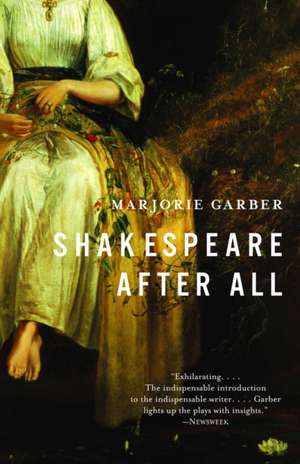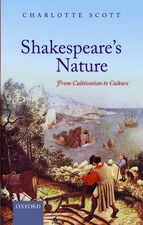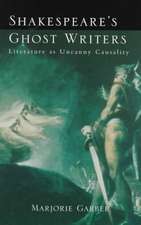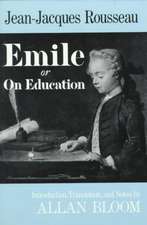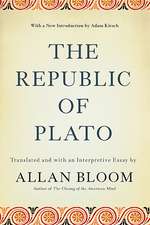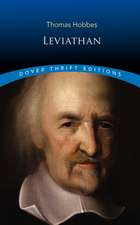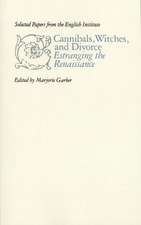Shakespeare After All: The Death Penalty and America's Future
Autor Garberen Limba Engleză Paperback – 31 dec 1899
Preț: 148.13 lei
Nou
Puncte Express: 222
Preț estimativ în valută:
28.34€ • 29.59$ • 23.46£
28.34€ • 29.59$ • 23.46£
Carte disponibilă
Livrare economică 14-28 martie
Livrare express 28 februarie-06 martie pentru 37.100 lei
Preluare comenzi: 021 569.72.76
Specificații
ISBN-13: 9780385722148
ISBN-10: 0385722141
Pagini: 989
Dimensiuni: 132 x 203 x 46 mm
Greutate: 0.68 kg
Editura: Anchor Books
ISBN-10: 0385722141
Pagini: 989
Dimensiuni: 132 x 203 x 46 mm
Greutate: 0.68 kg
Editura: Anchor Books
Notă biografică
Marjorie Garber is William R. Kenan, Jr., Professor of English and American Literature and Language and chair of the Department of Visual and Environmental Studies at Harvard University. She lives in Cambridge and Nantucket, Massachusetts.
From the Hardcover edition.
From the Hardcover edition.
Extras
Every age creates its own Shakespeare.
What is often described as the timelessness of Shakespeare, the transcendent qualities for which his plays have been praised around the world and across the centuries, is perhaps better understood as an uncanny timeliness, a capacity to speak directly to circumstances the playwright could not have anticipated or foreseen. Like a portrait whose eyes seem to follow you around the room, engaging your glance from every angle, the plays and their characters seem always to be “modern,” always to be “us.”
“He was not of an age, but for all time.” This was the verdict of Shakespeare’s great rival and admirer, the poet and playwright Ben Jonson, in a memorial poem affixed to the First Folio of Shakespeare’s plays. “Thou art a monument without a tomb,” wrote Jonson,
And art alive still, while thy book doth live,
And we have wits to read, and praise to give.
We might compare this passage to Shakespeare’s own famous lines in Sonnet 18, the sonnet that begins “Shall I compare thee to a summer’s day?” and ends:
So long as men can breathe or eyes can see,
So long lives this, and this gives life to thee.
The sonnets have indeed endured, and given life to the beloved addressee, but it is the sonnet that praises him, not the unnamed “fair youth” to whom the sonnet is written, that lives on in our eyes, ears, and memory.
Both “of an age” and “for all time,” Shakespeare is the defining figure of the English Renaissance, and the most cited and quoted author of every era since. But if we create our own Shakespeare, it is at least as true that the Shakespeare we create is a Shakespeare that has, to a certain extent, created us. The world in which we live and think and philosophize is, to use Ralph Waldo Emerson’s word, “Shakspearized.”
“I have a smack of Hamlet myself, if I do say so,” wrote Samuel Taylor Coleridge. Goethe thought so, too, and so did Sigmund Freud. So, indeed, did the actress Sarah Bernhardt, who, having played the role in a celebrated production in France in 1899, and again in London in 1901, declared that she could not imagine Hamlet as a man.
But perhaps Hamlet, a play that from the Romantic era on has been established as the premier Western performance of consciousness, is too obvious a case to make the point. Around the world and across the years, Macbeth has become a figure for ambition, Othello for jealous love, Lear a paradigm of neglected old age and its unexpected nobilities, Cleopatra a pattern of erotic and powerful womanhood, Prospero in The Tempest a model of the artist as philosopher and ruler. Romeo and Juliet are ubiquitous examples of young love, its idealism and excess. But if Shakespeare seems to us in a surprising way so “modern,” it’s because in a sense his language and his characters have created a lexicon of modernity. This is a book devoted in part to exploring the remarkable omnipresence of Shakespeare in our lives.
King Lear as written and performed in its original historical context was “about” pressing questions for the seventeenth century, like absolute monarchy, and royal succession and the obligations of vassals. For most citizens of the twenty-first century, “king” is an archaic title, as it emphatically was not for the subjects of James I, under whose patronage Shakespeare’s company, the King’s Men, performed and prospered. Mid-twentieth-century readers often translated “king” into “father,” seeing the drama as one centered on the family rather than the realm. Lear’s railing against the heavens has often been understood as existential. At various moments Lear became a sign of male power, of the pathos of aging, even of the end of an actor’s career. “King Lear” is a cultural icon, cited by philosophers, legislators, and politicians, as well as literary scholars—and gerontologists and therapists. The character has a cultural life derived from, but also distinct from, the play.
The Merchant of Venice is another powerful example of the translatability of these plays across the centuries. The first Shylock was a comic butt, who may have appeared in a red fright wig and a false nose, the standard signs of Jewishness on the Elizabethan stage. Shylock was played as a comic figure until the mid-eighteenth century, when the actor Charles Macklin transformed him into a villain. Only in the nineteenth century did Shylock become a sympathetic or a tragic figure, masterfully portrayed by Edmund Kean in a performance that impressed Romantic authors like Coleridge and William Hazlitt. (It was Coleridge who said that Kean had the gift of revealing Shakespeare by flashes of lightning.) The early twentieth century saw empathetic productions of the play in the Yiddish theater, as well as a monstrous Shylock performed in Weimar under the aegis of Nazi Germany. After the Holocaust an anti-Jewish portrayal of this figure seems almost unimaginable—which is not to say that it will not be attempted. The point is that the play has changed, along with the times. The Merchant of Venice itself has a history, a kind of cultural biography that has transformed it from its moment of origination. Although we can revisit and understand the context of production and of belief, from the sixteenth century and indeed from the sources that preceded Shakespeare, this play, like all the others, is a living, growing, changing work of art. The role it plays for contemporary readers, audiences, and cultural observers is to a certain extent a reflection of its own history.
The same is true with Othello. The question of Othello’s particularity as a black man and a Moor has been balanced against a certain desire to see him as a figure of universal humanity. This tendency toward generalization was in part an homage to Shakespeare, seen as a portrayer of universal types, and also a liberal shift away from racial stigmatizing, an attempt to dissociate the play from any tinct of bias. Earlier eras saw all too vividly the hero’s color, especially in places, like the United States, where race and inequality had for a long time been issues of national concern. In the later twentieth century, critics have emphasized the context of cultural oppression in the play, while others have wrestled with Othello’s tendency to acquiesce with assumptions of his inferiority. Black actors like James Earl Jones and Laurence Fishburne have displaced the blackface portrayals of the past. Productions still sometimes depict the character as consumed with self-doubt, but the heroic Othello has returned to the stage and screen—an Othello often portrayed as culturally identified with blackness and with his titular role as “the Moor of Venice.”
One more familiar example, that of The Tempest, may serve to reinforce this general observation about the changing and growing nature of the plays, and their place as cultural “shifters,” expanding their meanings as they intersect with new audiences and new circumstances in the world. After years as the premier art fable of Shakespearean drama, The Tempest, the story of an artist/creator often movingly described as “Shakespeare’s farewell to the stage” (although at least one more play would be written and staged by his company before what scholars think may have been his retirement to Stratford), The Tempest was reconsidered, in the later twentieth century, as a reflection upon English colonial explorations and “first encounter” narratives of the sixteenth and early seventeenth centuries. This reconsideration was framed in part by responses to colonial and postcolonial issues in the twentieth century, the century in which, and from which, critics and performers now regarded the play. Caliban’s otherness was now celebrated as difference rather than as cultural immaturity. Prospero’s famous concession, “This thing of darkness I / Acknowledge mine,” is addressed apparently to Caliban, but—as we will see—the “thing of darkness” is also something Prospero encounters in his own mind and soul. It is important to underscore the fact that postcolonial readings did not render the earlier understandings and resonances of The Tempest obsolete. Rather, they augmented, added nuance, questioned verities, such as Prospero’s wisdom and ideal mastery, and even toyed with the idea of reversals of power, giving Caliban and his co-conspirators an alternative voice in the play. Aimé Césaire’s Une Tempête and Roberto Fernández Retamar’s Calibán both give Shakespeare’s Tempest full-fledged postcolonial rewritings. The hallmark of a complex work of art is that it can not only endure but also benefit from any number of such strong rereadings. This, indeed, is one appropriate instrumental test of what we have come to call “greatness” in art and literature.
But where did “Shakespeare” stand on these questions? As I will suggest throughout the chapters that follow, the brilliant formal capacities of drama are such that the playwright’s voice is many voices. Shakespeare is Prospero, Caliban, Ariel, and the wondering Miranda. He is Othello, Desdemona and Iago, Shylock, Portia and Antonio. One of the tremendous achievements of these remarkable plays is the way one view will always answer another. Desdemona and Emilia debate women’s virtue from the “ideal” and “realist” viewpoints. Neither is definitively right. Both are “Shakespeare.” No sooner does Ulysses laud the universal value of “degree” and hierarchy than, in the next moment, he argues that the inferior Ajax be substituted for the incomparable Achilles. What is Shakespeare’s own view of such political questions? The answer—which is not an answer—lies in his plays. Yet so powerful has been the cultural effect of these plays that readers, critics, actors, and audiences often seek to align their meanings with Shakespeare’s biography.
In some eras, including our own, there has been a tendency, indeed a desire, to read the plays as indicators of Shakespeare’s mood, life crises, and frame of mind. Thus Thomas Carlyle asked rhetorically, “[H]ow could a man delineate a Hamlet, a Coriolanus, a Macbeth . . . if his own heroic heart had never suffered?”1 Certain passages in Hamlet, King Lear, and Troilus and Cressida were once taken as evidence of a certain “sex horror” on the part of the author, and were traced to his ambivalent relationship to his wife. The “last plays,” including the sublimely beautiful Winter’s Tale and The Tempest—not to mention Pericles, the most popular of Shakespeare’s plays in his lifetime—were dismissed out of hand by certain early-twentieth-century commentators like Lytton Strachey as infallible indications of the sad decline of a once-great writer who turned to the genre of romance out of boredom. The political, cultural, and social views of our own era are likewise grafted onto our Shakespeare, who has been, or has become, a keen analyst of power and gender. In essence, and in effect, we cannot resist creating our own Shakespeare. Again, I want to insist that this is a sign of strength in both playwright and critic, not a condition to be deplored or seen through.
The conditions of the stage in Shakespeare’s lifetime unquestionably shaped the kinds of plays and characters he produced. No women were permitted to perform on the English public stage. All the female roles in his plays were written for and performed by boy players, skilled adolescent apprentices with high voices that had not yet “cracked,” or changed. And yet Shakespeare created classic female characters who have become models of speech and conduct across the centuries, from the “shrew” Katherine to the loving daughters Cordelia and Miranda to Juliet, the modern paradigm of romantic love and longing.
The many cross-dressed roles in the plays took advantage of this material and historical fact, allowing both maleness and femaleness to be bodied forth in performance, and leading, in subsequent centuries, to a particular admiration for the liveliness and initiative of these Shakespearean women. Rosalind, played by a boy actor, cross-dresses as the boy “Ganymede” to enter the Forest of Arden; Portia, played by a boy actor, cross-dresses as the young doctor of laws to enter the courtroom in Venice; Viola, played by a boy actor, cross-dresses as the young man “Cesario” in Illyria; Imogen, played by a boy actor, cross-dresses as the boy “Fidele” in the Welsh hills.
The theaters were closed after 1642 during the Puritan Revolution, and when they reopened, after the restoration of the monarchy with the accession of Charles II in 1660, actresses did appear in female roles. Some traditionalists of the time decried the change, claiming that the boys had done a better job of playing women. English travelers to the continent had long held a similar view. Thomas Coryate, an English traveler in Venice, reported in 1608 that he “saw women acte, a thing that I never saw before—though I have heard that it hath been sometimes used in London—, and they performed it with as good a grace, action, gesture, and whatsoever convenient for a Player, as ever I saw any masculine Actor.”2 Rather than regarding this as foolishly retrograde on their part, we might consider the fact that female identity on the stage had become—like kingliness, madness, and exoticism—an aesthetically produced effect. The actors were not themselves kings, madmen, Moors, or shepherds, but they were able to portray those archtypes convincingly. This was not a matter of identity but of performance. The advent of actresses, some of them celebrated for their powerful performances of Shakespearean roles, changed forever how female parts—and female dramatic characters—were interpreted and understood.
Certainly the social politics of an era have had an effect upon interpretation. Modern productions of The Taming of the Shrew often struggle to absolve Shakespeare of antifeminism, much as productions of The Merchant of Venice try to underscore his empathy for Shylock the Jew or productions of Titus Andronicus to find some nobility in the villainous Aaron the Moor. Yet the brilliance and capaciousness of Shakespeare’s plays are such that almost always the “answer” to such social concerns is located right in the play. Iago would not be as powerful a character as he is if his words did not contain some painful and unwelcome “truth.” Prospero’s words do not always trump those of his “servants,” Caliban and Ariel.
Shakespeare always presents both his ideas and his character types con- trapuntally, offering a response and a qualification, another way of looking at things, within the play itself. Despite a concerted attempt to find it, there is no “Shakespearean” point of view, so that claims like “Shakespeare said” or “Shakespeare believed” or “Shakespeare tells us”—claims that sometimes seem to imply an authoritative and consistent philosophical consciousness—can always be exposed by looking at the context of the quotation. Shakespeare’s plays do not have a single voice, a lyric “I,” or a “focalized” character through whom the audience or reader is tacitly expected to interpret the play. Even in the extreme case of Hamlet’s musings, or in the more general case of the dramatic soliloquy, a powerful Shakespearean medium (often, again, excerpted as if it were an embedded lyric poem, a performance piece), the audience is given extensive evidence within the play to judge and evaluate the truth claims and ethical assertions that are so eloquently set forth by these charismatic speakers. We should remember that some of the most effective soliloquies, both in Shakespeare and elsewhere in English Renaissance drama, are put in the mouths of, and at the service of, Machiavellian characters: Richard III, Iago, Edmund in King Lear. And what they say is seductive, sometimes persuasive, and usually effective, at least in the short term. Yet it is no more—or less—accurate to say that “Shakespeare’s philosophy” is that of Edmund than it is to say that his philosophy is that of Hamlet.
The Stage and the Page
There has always been a productive tension between the idea of the play as a poem or a text and the idea of the play as a performance. Some portions of Shakespeare’s plays are inaccessible to us because they are made up of spectacles or performances rather than words. Examples include the masque in The Tempest; the apparitions in Macbeth; the tilt, or challenge, in Pericles; the descended god Jupiter in Cymbeline; and music throughout the comedies, including the music that is the “food of love” in Orsino’s opening speech in Twelfth Night, but that has, by the end of the speech, become “not so sweet now as it was before.” Battle scenes, like those in the English history plays and in Antony and Cleo- patra, are also moments of high visual interest and onstage action, important to the tenor and pace of the play, and easy to underestimate (or skip over entirely) if one reads the plays as literature rather than visualizing them as theater.
Since the texts (today we would say “scripts”) of stage plays were not generally regarded as “literature,” many of the first published versions of the plays are of uncertain authority. In these years before copyright, first introduced in England in 1709, authors did not control the printing of their plays. The printer, or bookseller, took the profit, and the author sometimes had little or no opportunity to review or affect what was published. The editors of the First Folio of Shakespeare make this very clear in their letter to the readers: “[W]here before you were abused with diverse stolen and surreptitious copies, maimed and deformed by the frauds and stealths of injurious impostors that exposed them: even those are now offered to your view cured, and perfect of their limbs, and . . . absolute in their numbers.”
From the Hardcover edition.
What is often described as the timelessness of Shakespeare, the transcendent qualities for which his plays have been praised around the world and across the centuries, is perhaps better understood as an uncanny timeliness, a capacity to speak directly to circumstances the playwright could not have anticipated or foreseen. Like a portrait whose eyes seem to follow you around the room, engaging your glance from every angle, the plays and their characters seem always to be “modern,” always to be “us.”
“He was not of an age, but for all time.” This was the verdict of Shakespeare’s great rival and admirer, the poet and playwright Ben Jonson, in a memorial poem affixed to the First Folio of Shakespeare’s plays. “Thou art a monument without a tomb,” wrote Jonson,
And art alive still, while thy book doth live,
And we have wits to read, and praise to give.
We might compare this passage to Shakespeare’s own famous lines in Sonnet 18, the sonnet that begins “Shall I compare thee to a summer’s day?” and ends:
So long as men can breathe or eyes can see,
So long lives this, and this gives life to thee.
The sonnets have indeed endured, and given life to the beloved addressee, but it is the sonnet that praises him, not the unnamed “fair youth” to whom the sonnet is written, that lives on in our eyes, ears, and memory.
Both “of an age” and “for all time,” Shakespeare is the defining figure of the English Renaissance, and the most cited and quoted author of every era since. But if we create our own Shakespeare, it is at least as true that the Shakespeare we create is a Shakespeare that has, to a certain extent, created us. The world in which we live and think and philosophize is, to use Ralph Waldo Emerson’s word, “Shakspearized.”
“I have a smack of Hamlet myself, if I do say so,” wrote Samuel Taylor Coleridge. Goethe thought so, too, and so did Sigmund Freud. So, indeed, did the actress Sarah Bernhardt, who, having played the role in a celebrated production in France in 1899, and again in London in 1901, declared that she could not imagine Hamlet as a man.
But perhaps Hamlet, a play that from the Romantic era on has been established as the premier Western performance of consciousness, is too obvious a case to make the point. Around the world and across the years, Macbeth has become a figure for ambition, Othello for jealous love, Lear a paradigm of neglected old age and its unexpected nobilities, Cleopatra a pattern of erotic and powerful womanhood, Prospero in The Tempest a model of the artist as philosopher and ruler. Romeo and Juliet are ubiquitous examples of young love, its idealism and excess. But if Shakespeare seems to us in a surprising way so “modern,” it’s because in a sense his language and his characters have created a lexicon of modernity. This is a book devoted in part to exploring the remarkable omnipresence of Shakespeare in our lives.
King Lear as written and performed in its original historical context was “about” pressing questions for the seventeenth century, like absolute monarchy, and royal succession and the obligations of vassals. For most citizens of the twenty-first century, “king” is an archaic title, as it emphatically was not for the subjects of James I, under whose patronage Shakespeare’s company, the King’s Men, performed and prospered. Mid-twentieth-century readers often translated “king” into “father,” seeing the drama as one centered on the family rather than the realm. Lear’s railing against the heavens has often been understood as existential. At various moments Lear became a sign of male power, of the pathos of aging, even of the end of an actor’s career. “King Lear” is a cultural icon, cited by philosophers, legislators, and politicians, as well as literary scholars—and gerontologists and therapists. The character has a cultural life derived from, but also distinct from, the play.
The Merchant of Venice is another powerful example of the translatability of these plays across the centuries. The first Shylock was a comic butt, who may have appeared in a red fright wig and a false nose, the standard signs of Jewishness on the Elizabethan stage. Shylock was played as a comic figure until the mid-eighteenth century, when the actor Charles Macklin transformed him into a villain. Only in the nineteenth century did Shylock become a sympathetic or a tragic figure, masterfully portrayed by Edmund Kean in a performance that impressed Romantic authors like Coleridge and William Hazlitt. (It was Coleridge who said that Kean had the gift of revealing Shakespeare by flashes of lightning.) The early twentieth century saw empathetic productions of the play in the Yiddish theater, as well as a monstrous Shylock performed in Weimar under the aegis of Nazi Germany. After the Holocaust an anti-Jewish portrayal of this figure seems almost unimaginable—which is not to say that it will not be attempted. The point is that the play has changed, along with the times. The Merchant of Venice itself has a history, a kind of cultural biography that has transformed it from its moment of origination. Although we can revisit and understand the context of production and of belief, from the sixteenth century and indeed from the sources that preceded Shakespeare, this play, like all the others, is a living, growing, changing work of art. The role it plays for contemporary readers, audiences, and cultural observers is to a certain extent a reflection of its own history.
The same is true with Othello. The question of Othello’s particularity as a black man and a Moor has been balanced against a certain desire to see him as a figure of universal humanity. This tendency toward generalization was in part an homage to Shakespeare, seen as a portrayer of universal types, and also a liberal shift away from racial stigmatizing, an attempt to dissociate the play from any tinct of bias. Earlier eras saw all too vividly the hero’s color, especially in places, like the United States, where race and inequality had for a long time been issues of national concern. In the later twentieth century, critics have emphasized the context of cultural oppression in the play, while others have wrestled with Othello’s tendency to acquiesce with assumptions of his inferiority. Black actors like James Earl Jones and Laurence Fishburne have displaced the blackface portrayals of the past. Productions still sometimes depict the character as consumed with self-doubt, but the heroic Othello has returned to the stage and screen—an Othello often portrayed as culturally identified with blackness and with his titular role as “the Moor of Venice.”
One more familiar example, that of The Tempest, may serve to reinforce this general observation about the changing and growing nature of the plays, and their place as cultural “shifters,” expanding their meanings as they intersect with new audiences and new circumstances in the world. After years as the premier art fable of Shakespearean drama, The Tempest, the story of an artist/creator often movingly described as “Shakespeare’s farewell to the stage” (although at least one more play would be written and staged by his company before what scholars think may have been his retirement to Stratford), The Tempest was reconsidered, in the later twentieth century, as a reflection upon English colonial explorations and “first encounter” narratives of the sixteenth and early seventeenth centuries. This reconsideration was framed in part by responses to colonial and postcolonial issues in the twentieth century, the century in which, and from which, critics and performers now regarded the play. Caliban’s otherness was now celebrated as difference rather than as cultural immaturity. Prospero’s famous concession, “This thing of darkness I / Acknowledge mine,” is addressed apparently to Caliban, but—as we will see—the “thing of darkness” is also something Prospero encounters in his own mind and soul. It is important to underscore the fact that postcolonial readings did not render the earlier understandings and resonances of The Tempest obsolete. Rather, they augmented, added nuance, questioned verities, such as Prospero’s wisdom and ideal mastery, and even toyed with the idea of reversals of power, giving Caliban and his co-conspirators an alternative voice in the play. Aimé Césaire’s Une Tempête and Roberto Fernández Retamar’s Calibán both give Shakespeare’s Tempest full-fledged postcolonial rewritings. The hallmark of a complex work of art is that it can not only endure but also benefit from any number of such strong rereadings. This, indeed, is one appropriate instrumental test of what we have come to call “greatness” in art and literature.
But where did “Shakespeare” stand on these questions? As I will suggest throughout the chapters that follow, the brilliant formal capacities of drama are such that the playwright’s voice is many voices. Shakespeare is Prospero, Caliban, Ariel, and the wondering Miranda. He is Othello, Desdemona and Iago, Shylock, Portia and Antonio. One of the tremendous achievements of these remarkable plays is the way one view will always answer another. Desdemona and Emilia debate women’s virtue from the “ideal” and “realist” viewpoints. Neither is definitively right. Both are “Shakespeare.” No sooner does Ulysses laud the universal value of “degree” and hierarchy than, in the next moment, he argues that the inferior Ajax be substituted for the incomparable Achilles. What is Shakespeare’s own view of such political questions? The answer—which is not an answer—lies in his plays. Yet so powerful has been the cultural effect of these plays that readers, critics, actors, and audiences often seek to align their meanings with Shakespeare’s biography.
In some eras, including our own, there has been a tendency, indeed a desire, to read the plays as indicators of Shakespeare’s mood, life crises, and frame of mind. Thus Thomas Carlyle asked rhetorically, “[H]ow could a man delineate a Hamlet, a Coriolanus, a Macbeth . . . if his own heroic heart had never suffered?”1 Certain passages in Hamlet, King Lear, and Troilus and Cressida were once taken as evidence of a certain “sex horror” on the part of the author, and were traced to his ambivalent relationship to his wife. The “last plays,” including the sublimely beautiful Winter’s Tale and The Tempest—not to mention Pericles, the most popular of Shakespeare’s plays in his lifetime—were dismissed out of hand by certain early-twentieth-century commentators like Lytton Strachey as infallible indications of the sad decline of a once-great writer who turned to the genre of romance out of boredom. The political, cultural, and social views of our own era are likewise grafted onto our Shakespeare, who has been, or has become, a keen analyst of power and gender. In essence, and in effect, we cannot resist creating our own Shakespeare. Again, I want to insist that this is a sign of strength in both playwright and critic, not a condition to be deplored or seen through.
The conditions of the stage in Shakespeare’s lifetime unquestionably shaped the kinds of plays and characters he produced. No women were permitted to perform on the English public stage. All the female roles in his plays were written for and performed by boy players, skilled adolescent apprentices with high voices that had not yet “cracked,” or changed. And yet Shakespeare created classic female characters who have become models of speech and conduct across the centuries, from the “shrew” Katherine to the loving daughters Cordelia and Miranda to Juliet, the modern paradigm of romantic love and longing.
The many cross-dressed roles in the plays took advantage of this material and historical fact, allowing both maleness and femaleness to be bodied forth in performance, and leading, in subsequent centuries, to a particular admiration for the liveliness and initiative of these Shakespearean women. Rosalind, played by a boy actor, cross-dresses as the boy “Ganymede” to enter the Forest of Arden; Portia, played by a boy actor, cross-dresses as the young doctor of laws to enter the courtroom in Venice; Viola, played by a boy actor, cross-dresses as the young man “Cesario” in Illyria; Imogen, played by a boy actor, cross-dresses as the boy “Fidele” in the Welsh hills.
The theaters were closed after 1642 during the Puritan Revolution, and when they reopened, after the restoration of the monarchy with the accession of Charles II in 1660, actresses did appear in female roles. Some traditionalists of the time decried the change, claiming that the boys had done a better job of playing women. English travelers to the continent had long held a similar view. Thomas Coryate, an English traveler in Venice, reported in 1608 that he “saw women acte, a thing that I never saw before—though I have heard that it hath been sometimes used in London—, and they performed it with as good a grace, action, gesture, and whatsoever convenient for a Player, as ever I saw any masculine Actor.”2 Rather than regarding this as foolishly retrograde on their part, we might consider the fact that female identity on the stage had become—like kingliness, madness, and exoticism—an aesthetically produced effect. The actors were not themselves kings, madmen, Moors, or shepherds, but they were able to portray those archtypes convincingly. This was not a matter of identity but of performance. The advent of actresses, some of them celebrated for their powerful performances of Shakespearean roles, changed forever how female parts—and female dramatic characters—were interpreted and understood.
Certainly the social politics of an era have had an effect upon interpretation. Modern productions of The Taming of the Shrew often struggle to absolve Shakespeare of antifeminism, much as productions of The Merchant of Venice try to underscore his empathy for Shylock the Jew or productions of Titus Andronicus to find some nobility in the villainous Aaron the Moor. Yet the brilliance and capaciousness of Shakespeare’s plays are such that almost always the “answer” to such social concerns is located right in the play. Iago would not be as powerful a character as he is if his words did not contain some painful and unwelcome “truth.” Prospero’s words do not always trump those of his “servants,” Caliban and Ariel.
Shakespeare always presents both his ideas and his character types con- trapuntally, offering a response and a qualification, another way of looking at things, within the play itself. Despite a concerted attempt to find it, there is no “Shakespearean” point of view, so that claims like “Shakespeare said” or “Shakespeare believed” or “Shakespeare tells us”—claims that sometimes seem to imply an authoritative and consistent philosophical consciousness—can always be exposed by looking at the context of the quotation. Shakespeare’s plays do not have a single voice, a lyric “I,” or a “focalized” character through whom the audience or reader is tacitly expected to interpret the play. Even in the extreme case of Hamlet’s musings, or in the more general case of the dramatic soliloquy, a powerful Shakespearean medium (often, again, excerpted as if it were an embedded lyric poem, a performance piece), the audience is given extensive evidence within the play to judge and evaluate the truth claims and ethical assertions that are so eloquently set forth by these charismatic speakers. We should remember that some of the most effective soliloquies, both in Shakespeare and elsewhere in English Renaissance drama, are put in the mouths of, and at the service of, Machiavellian characters: Richard III, Iago, Edmund in King Lear. And what they say is seductive, sometimes persuasive, and usually effective, at least in the short term. Yet it is no more—or less—accurate to say that “Shakespeare’s philosophy” is that of Edmund than it is to say that his philosophy is that of Hamlet.
The Stage and the Page
There has always been a productive tension between the idea of the play as a poem or a text and the idea of the play as a performance. Some portions of Shakespeare’s plays are inaccessible to us because they are made up of spectacles or performances rather than words. Examples include the masque in The Tempest; the apparitions in Macbeth; the tilt, or challenge, in Pericles; the descended god Jupiter in Cymbeline; and music throughout the comedies, including the music that is the “food of love” in Orsino’s opening speech in Twelfth Night, but that has, by the end of the speech, become “not so sweet now as it was before.” Battle scenes, like those in the English history plays and in Antony and Cleo- patra, are also moments of high visual interest and onstage action, important to the tenor and pace of the play, and easy to underestimate (or skip over entirely) if one reads the plays as literature rather than visualizing them as theater.
Since the texts (today we would say “scripts”) of stage plays were not generally regarded as “literature,” many of the first published versions of the plays are of uncertain authority. In these years before copyright, first introduced in England in 1709, authors did not control the printing of their plays. The printer, or bookseller, took the profit, and the author sometimes had little or no opportunity to review or affect what was published. The editors of the First Folio of Shakespeare make this very clear in their letter to the readers: “[W]here before you were abused with diverse stolen and surreptitious copies, maimed and deformed by the frauds and stealths of injurious impostors that exposed them: even those are now offered to your view cured, and perfect of their limbs, and . . . absolute in their numbers.”
From the Hardcover edition.
Recenzii
“The indispensable introduction to the indispensable writer. . . . Garber’s is the most exhilarating seminar room you’ll ever enter.” –Newsweek
“The best one-volume critical guide to the plays. . . . Stimulating and informative.” –San Jose Mercury News
“An enraptured ceremony of adoration. . . . Ambitious and thorough. . . . This is a useful book [and] a source of elucidation.” –Newsday
“[Garber’s] introduction is an exemplary account of what is known about Shakespeare and how his work has been read and regarded through the centuries, while the individual essays display scrupulous and subtle close reading.” –The New Yorker
“The best one-volume critical guide to the plays. . . . Stimulating and informative.” –San Jose Mercury News
“An enraptured ceremony of adoration. . . . Ambitious and thorough. . . . This is a useful book [and] a source of elucidation.” –Newsday
“[Garber’s] introduction is an exemplary account of what is known about Shakespeare and how his work has been read and regarded through the centuries, while the individual essays display scrupulous and subtle close reading.” –The New Yorker
Cuprins
A Note on the Text
Introduction
The Two Gentlemen of Verona
The Taming of the Shrew
Titus Andronicus
Henry VI Part 1
Henry VI Part 2
Henry VI Part 3
Richard III
The Comedy of Errors
Love’s Labour’s Lost
Romeo and Juliet
A Midsummer Night’s Dream
Richard II
King John
The Merchant of Venice
Henry IV Part 1
Henry IV Part 2
The Merry Wives of Windsor
Much Ado About Nothing
Henry V
Julius Caesar
As You Like It
Hamlet
Twelfth Night
Troilus and Cressida
Measure for Measure
Othello
All’s Well That Ends Well
Timon of Athens
King Lear
Macbeth
Antony and Cleopatra
Pericles
Coriolanus
Cymbeline
The Winter’s Tale
The Tempest
Henry VIII (All Is True)
The Two Noble Kinsmen
Notes
Suggestions for Further Reading
Acknowledgments
General Index
Character Index
Introduction
The Two Gentlemen of Verona
The Taming of the Shrew
Titus Andronicus
Henry VI Part 1
Henry VI Part 2
Henry VI Part 3
Richard III
The Comedy of Errors
Love’s Labour’s Lost
Romeo and Juliet
A Midsummer Night’s Dream
Richard II
King John
The Merchant of Venice
Henry IV Part 1
Henry IV Part 2
The Merry Wives of Windsor
Much Ado About Nothing
Henry V
Julius Caesar
As You Like It
Hamlet
Twelfth Night
Troilus and Cressida
Measure for Measure
Othello
All’s Well That Ends Well
Timon of Athens
King Lear
Macbeth
Antony and Cleopatra
Pericles
Coriolanus
Cymbeline
The Winter’s Tale
The Tempest
Henry VIII (All Is True)
The Two Noble Kinsmen
Notes
Suggestions for Further Reading
Acknowledgments
General Index
Character Index
Descriere
Richly informed by Shakespearean scholarship of the latter half of the 20th century, this book offers passionate and revealing readings of all 38 of Shakespeare's plays, in chronological sequence.
